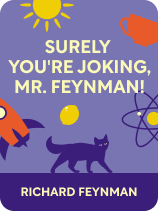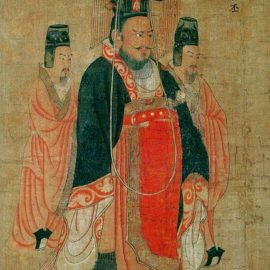

This article is an excerpt from the Shortform book guide to "Surely You're Joking, Mr. Feynman!" by Richard Feynman. Shortform has the world's best summaries and analyses of books you should be reading.
Like this article? Sign up for a free trial here.
What was Richard Feynman’s contribution to the Manhattan Project? How did he look back on the experience?
In the early 1940s, Richard Feynman was working on his doctorate at Princeton. An army general arrived on campus to recruit physicists. Feynman signed up, having no idea how his decision would change his life and put him at the center of a project that would change the world.
Read more to learn about Richard Feynman, the Manhattan Project, and the dawning of a new era.
The Manhattan Project
For Richard Feynman, the Manhattan Project was a patriotic duty, though he knew precious little when he volunteered to participate. As he approached the end of his graduate studies, the US entered the Second World War. Feynman would contribute his intellectual gifts as part of the theoretical team that developed the atomic bomb. While Feynman would begin as a low-ranking recruit, he would play an important role in the advancement of the atom bomb project, though the ultimate success of his military mission would coincide with a great personal tragedy.
Like many Americans, Feynman felt it was his duty to contribute to the war effort, but he didn’t want to go to army boot camp; he believed he could better serve in a technical position. While he was still working on his Ph.D., a general came to Princeton looking for physicists to recruit, and Feynman volunteered, even though at the time very few people even understood what a physicist was. Feynman says his first job was working on an analog computer to help artillery target enemy aircraft—work that centered on tinkering with gears and engineering design, rather than Feynman’s area of expertise, which was theoretical physics.
(Shortform note: The purely mechanical “computer” that Feynman worked on was nothing like the digital computers of today. Nevertheless, during World War II, analog targeting computers were essential to the success of many military operations. Systems such as the British Army’s Kerrison Predictor and the US Navy’s Mark 1 Fire Control Computer calculated factors such as the speed, direction, and distance of a target to accurately aim artillery and naval guns. Such computers used systems of differential gears, input shafts, and rotating surfaces to perform calculations and required skilled operators to use them effectively.)
After earning his doctorate, Feynman was recruited into the top-secret Manhattan Project team at Los Alamos, New Mexico, to develop the atomic bomb. In the beginning, he was a low-ranking member of the theoretical physics team whose first assignment was to consult with various engineering groups. When the scientists arrived at Los Alamos, the facilities were still under construction, so the experimental physics group lent a hand while theoreticians such as Feynman started work in whatever space was available. Despite his Ph.D., Feynman recalls that he wasn’t knowledgeable about nuclear physics, and he felt he had a lot of catching up to do.
(Shortform note: The Manhattan Project was a top-secret research program to develop the first nuclear weapons before Germany or Japan could do the same. Its scientists were recruited based on their expertise and knowledge in various fields related to nuclear physics, chemistry, and engineering. The initial group of scientists was selected by the project’s scientific director, J. Robert Oppenheimer, in consultation with the project’s military leaders. The recruitment process focused on identifying individuals with exceptional scientific ability, creativity, and dedication to the war effort. Though Feynman wasn’t the youngest scientist on the project—that was the spy, Theodore Hall—at the age of 23, Feynman was already being compared to Albert Einstein for his skills as a theoretician.)
Feynman also admits to being a troublemaker, sometimes accidentally and sometimes on purpose. For example, when he was assigned a room in the dormitory for scientists, he decided that he didn’t want a roommate, so he would ruffle the bed and leave some of his wife Arline’s belongings around so that it looked like she was with him, when in fact she was convalescing at a hospital in Albuquerque. Unknown to him at the time, the fact that he was supposedly living with a woman in a men-only dorm went up the chain of command and caused a policy ruckus at the highest level of the project’s management.
(Shortform note: Feynman met and proposed to his first wife, Arline (née Greenbaum), while they were both still in high school. In Genius, biographer James Gleick writes that Arline soon came down with a chronic illness later diagnosed as a rare form of tuberculosis, which was untreatable at the time and considered a terminal condition. Nevertheless, Arline and Feynman married in 1942, despite the fact that being married went against the conditions of Feynman’s graduate funding. Feynman’s relationship with Arline was dramatized in the 1996 film Infinity, starring Matthew Broderick as Feynman and Patricia Arquette as Arline.)
However, Feynman claims that the group at Los Alamos he probably irritated the most were those in charge of censoring the mail. He and his wife wrote to each other regularly, but certain topics, details, or even words (such as the fact that the mail was being censored) weren’t allowed in correspondence. Feynman grew so frustrated by this that he and his wife started writing in code, which drove the mail censors crazy. The struggle between Feynman, his wife, and the censors grew to such a contest that he began to place bets on what he would or wouldn’t be able to get past them.
(Shortform note: Despite Feynman’s levity on the subject, security around the Manhattan Project was tight, including thorough background checks by the FBI for every person working on the site, even construction and maintenance personnel. Since the very existence of the atom bomb program had to be kept secret, the US Congress had to take steps to keep its budget concealed, not only from the nation but from the military as well. The Manhattan Project wasn’t publicly revealed until after the bombing of Nagasaki in 1945.)
Computing Power
The most significant contribution Feynman discusses was his work on the project’s computing machines. Los Alamos was supplied with an assortment of hand calculators and IBM adding machines, which Feynman and other physicists learned to assemble and repair on their own. “Computer programs” were run by a roomful of machines manned by workers who would perform calculations in an assembly line fashion. Feynman recounts that, when he was put in charge of the computing staff, he pleaded for permission to explain to the workers what they were doing and why it was important.
Once he spoke with the workers, their computations increased by a factor of 10, and they came up with innovative ways for the assembly line to work on several problems at once. In a completely analog environment, passing punch cards from one machine to another, Feynman’s crew turned the computing room into an efficient, parallel-processing, problem-solving machine that greatly sped up the calculations needed to advance the development of the bomb.
| Calculators of the 1940s Calculators and adding machines in the 1940s were mechanical devices that used a combination of gears, levers, and other mechanical components to perform arithmetic calculations. They were typically operated by entering numbers using a keyboard, which would trigger the movement of gears and levers to add the numbers together. Some adding machines were also capable of subtraction, multiplication, and division, using similar mechanical processes. They were often large and heavy, with complex internal mechanisms, and required regular maintenance to keep them in working order. International Business Machines (IBM) dedicated all of its resources to the US war effort during the 1940s and thus provided all the calculators used by the Manhattan Project. Its adding machines of the time were known for their durability and ability to perform thousands of calculations per hour. Their machines accomplished this by using numeric punch cards to increase the input and output of data to a speed of up to 80 cards per minute. |
Feynman’s World Changes
July 16, 1945, was the date of the first atomic bomb detonation. During the bomb test, Feynman went without protective glasses, watching the blast with his naked eyes. Exactly one month before, on June 16, Feynman’s wife Arline had died of tuberculosis. Since she’d been ill for several years, her death wasn’t unexpected, but his initial reaction was muted. Feynman recalls that it wasn’t until months later that he broke into tears when he saw a dress she might have liked, and the full weight of his grief struck at once.
(Shortform note: It’s possible that Feynman suffered a period of depression following his wife’s death, as well as during other times in his life, such as when his father died a year later. While researching Genius, biographer James Gleick discovered a letter that Feynman wrote to Arline two years after her death in which Feynman describes his inability to fall in love with anyone else. In Feynman’s second memoir, What Do You Care What Other People Think? he describes undergoing electroconvulsive therapy to treat his depression, which had the side effect of causing temporary memory loss.)
The world now seemed like a wholly different place, one without his wife but with nuclear weapons. He would find himself sitting at lunch calculating the damage if a bomb went off where he was. Feynman claims that while working on the Manhattan Project, neither he nor his colleagues gave any thought to the ultimate impact of what they were creating. Their focus was simply on getting the job done. Afterward, however, Feynman was struck by a sense of futility. What was the point of creating anything new in a world where atomic bombs could destroy everything in a heartbeat? Despite beginning the project with good intentions, Feynman’s despair plagued him for some time.
(Shortform note: Feynman wasn’t the only Manhattan Project scientist to experience guilt and regret over the consequences of their work and the potential for nuclear weapons to be used in the future. Physicist Joseph Rotblat was so appalled by the direction of the research that he left the project before it was complete and later won the Nobel Peace Prize for his advocacy of nuclear disarmament. When J. Robert Oppenheimer opposed further development of nuclear weapons after the end of the war, he was fired from his position on the US Atomic Energy Commission and accused of having Communist sympathies.)

———End of Preview———
Like what you just read? Read the rest of the world's best book summary and analysis of Richard Feynman's "Surely You're Joking, Mr. Feynman!" at Shortform.
Here's what you'll find in our full Surely You're Joking, Mr. Feynman! summary:
- The memoir of award-winning scientist Richard Feynman
- A walk through Feynman's life, from college to winning the Nobel Prize
- Why enjoying life is just as valuable as your education






